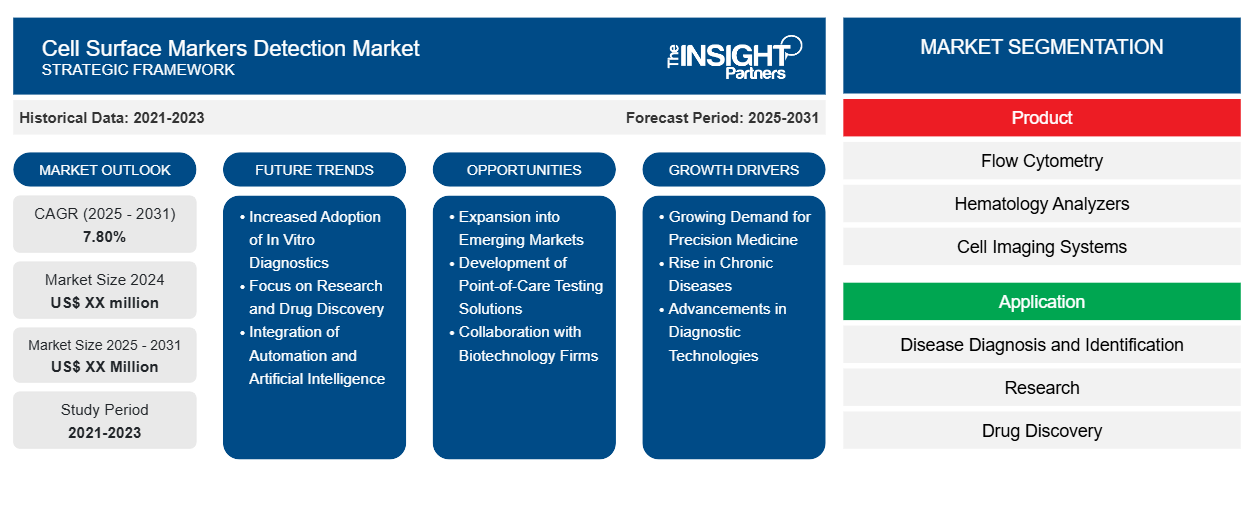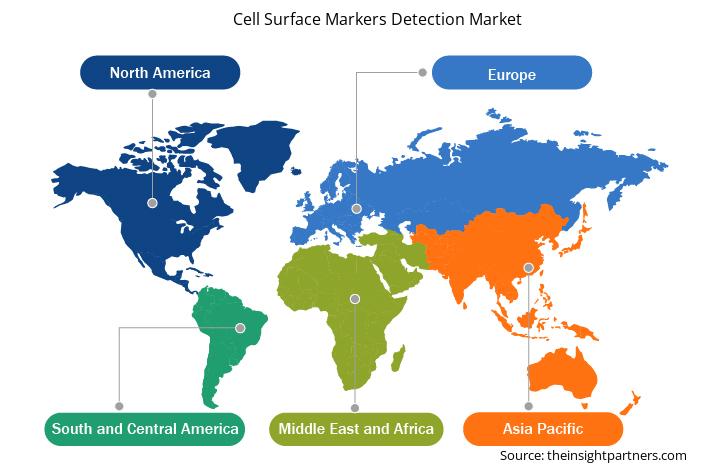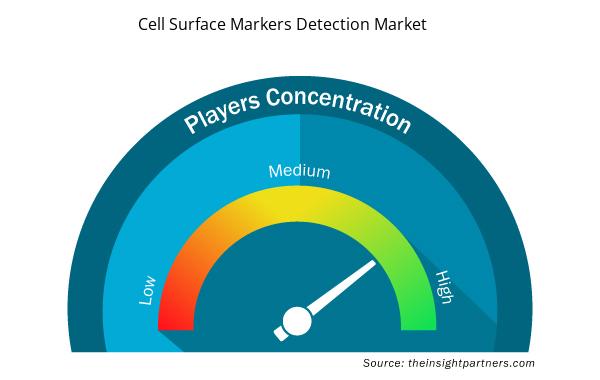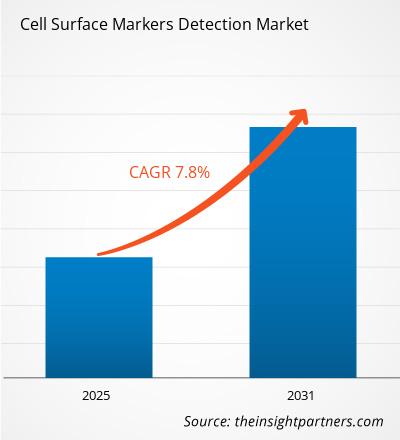The Cell Surface Markers Detection Market is expected to register a CAGR of 7.80% from 2025 to 2031, with a market size expanding from US$ XX million in 2024 to US$ XX Million by 2031.
The report presents an analysis based on Product (Flow Cytometry, Hematology Analyzers, Cell Imaging Systems, Reagents and Kits, and Other Products). The report further provides analysis based on Application (Disease Diagnosis and Identification, Research, and Drug Discovery, and Other Applications). The global analysis is further broken-down at regional level and major countries. The market size and forecast at global, regional, and country levels for all the key market segments are covered under the scope. The report offers the value in USD for the above analysis and segments. The report provides key statistics on the market status of the key market players and offers market trends and opportunities.
Purpose of the Report
The report Cell Surface Markers Detection Market by The Insight Partners aims to describe the present landscape and future growth, top driving factors, challenges, and opportunities. This will provide insights to various business stakeholders, such as:
- Technology Providers/Manufacturers: To understand the evolving market dynamics and know the potential growth opportunities, enabling them to make informed strategic decisions.
- Investors: To conduct a comprehensive trend analysis regarding the market growth rate, market financial projections, and opportunities that exist across the value chain.
- Regulatory bodies: To regulate policies and police activities in the market with the aim of minimizing abuse, preserving investor trust and confidence, and upholding the integrity and stability of the market.
Cell Surface Markers Detection Market Segmentation
Product
- Flow Cytometry
- Hematology Analyzers
- Cell Imaging Systems
- Reagents and Kits
- Other Products
Application
- Disease Diagnosis and Identification
- Research
- Drug Discovery
- Other Applications
Customize This Report To Suit Your Requirement
You will get customization on any report - free of charge - including parts of this report, or country-level analysis, Excel Data pack, as well as avail great offers and discounts for start-ups & universities
Cell Surface Markers Detection Market: Strategic Insights

- Get Top Key Market Trends of this report.This FREE sample will include data analysis, ranging from market trends to estimates and forecasts.
Cell Surface Markers Detection Market Growth Drivers
- Growing Demand for Precision Medicine: The increasing emphasis on precision medicine is a primary driver of the cell surface markers detection market. This approach relies heavily on accurate disease diagnosis and personalized treatment plans tailored to individual patient profiles. As healthcare systems shift towards targeted therapies, the need for precise identification of cell surface markers becomes critical. This trend is expected to propel market growth as healthcare providers seek advanced diagnostic tools to enhance treatment efficacy and patient outcomes.
- Rise in Chronic Diseases: The rising prevalence of chronic diseases, particularly cancers and autoimmune disorders, significantly contributes to the demand for cell surface marker detection. Accurate and early diagnosis is vital for effective treatment strategies, making cell surface markers indispensable in clinical settings. The increasing burden of these diseases necessitates innovative diagnostic solutions, driving market expansion as researchers and clinicians seek reliable methods for disease monitoring and management.
- Advancements in Diagnostic Technologies: Technological advancements play a crucial role in the growth of the cell surface markers detection market. Innovations such as high-throughput screening, automation, and improved imaging techniques enhance the efficiency and accuracy of detecting cell surface markers. These advancements not only simplify complex procedures but also increase accessibility for various applications, including research and clinical diagnostics. As technology continues to evolve, it will further support the market's expansion.
Cell Surface Markers Detection Market Future Trends
- Increased Adoption of In Vitro Diagnostics: There is a notable trend towards the increased adoption of in vitro diagnostics (IVD) in healthcare settings. IVDs rely heavily on cell surface markers for disease detection and monitoring, making them essential tools in modern diagnostics. The growing demand for rapid and accurate diagnostic solutions is driving this trend, as healthcare providers seek to improve patient outcomes through timely interventions. This shift is expected to significantly boost the cell surface marker detection market.
- Focus on Research and Drug Discovery: The cell surface marker detection market is experiencing a trend towards enhanced focus on research and drug discovery. With the rising prevalence of chronic diseases, there is an urgent need for new therapeutic options, prompting increased investment in research initiatives. Collaborations between pharmaceutical companies and research institutions are fostering innovation in this area, leading to a greater emphasis on understanding cell biology through advanced detection techniques.
- Integration of Automation and Artificial Intelligence: The integration of automation and artificial intelligence (AI) into diagnostic processes is transforming the cell surface marker detection landscape. Automated systems enhance throughput and reduce human error, while AI algorithms improve data analysis capabilities. This trend not only streamlines laboratory workflows but also enhances diagnostic accuracy, making it easier for researchers and clinicians to interpret complex data sets related to cell surface markers.
Cell Surface Markers Detection Market Opportunities
- Expansion into Emerging Markets: Emerging markets present unique opportunities for growth in the cell surface markers detection market. As healthcare infrastructure improves in regions such as Asia-Pacific and Latin America, there is an increasing demand for advanced diagnostic tools. Companies can capitalize on this growth by tailoring their products to meet local needs, thereby expanding their market presence while contributing to improved healthcare outcomes in these regions.
- Development of Point-of-Care Testing Solutions: There is a significant opportunity for innovation in point-of-care (POC) testing solutions that utilize cell surface markers for rapid diagnostics. As healthcare shifts towards more accessible testing options, developing POC devices can enhance patient care by providing immediate results outside traditional laboratory settings. This approach can improve disease management and facilitate timely interventions, making it an attractive area for investment.
- Collaboration with Biotechnology Firms: Collaborations between diagnostic companies and biotechnology firms offer substantial opportunities for advancing cell surface marker detection technologies. By partnering with organizations focused on innovative research, companies can leverage shared expertise to develop cutting-edge solutions that meet evolving market demands. These collaborations can accelerate product development timelines while enhancing competitiveness in a rapidly changing landscape.
Cell Surface Markers Detection Market Regional Insights
The regional trends and factors influencing the Cell Surface Markers Detection Market throughout the forecast period have been thoroughly explained by the analysts at Insight Partners. This section also discusses Cell Surface Markers Detection Market segments and geography across North America, Europe, Asia Pacific, Middle East and Africa, and South and Central America.

- Get the Regional Specific Data for Cell Surface Markers Detection Market
Cell Surface Markers Detection Market Report Scope
| Report Attribute | Details |
|---|---|
| Market size in 2024 | US$ XX million |
| Market Size by 2031 | US$ XX Million |
| Global CAGR (2025 - 2031) | 7.80% |
| Historical Data | 2021-2023 |
| Forecast period | 2025-2031 |
| Segments Covered |
By Product
|
| Regions and Countries Covered | North America
|
| Market leaders and key company profiles |
Cell Surface Markers Detection Market Players Density: Understanding Its Impact on Business Dynamics
The Cell Surface Markers Detection Market market is growing rapidly, driven by increasing end-user demand due to factors such as evolving consumer preferences, technological advancements, and greater awareness of the product's benefits. As demand rises, businesses are expanding their offerings, innovating to meet consumer needs, and capitalizing on emerging trends, which further fuels market growth.
Market players density refers to the distribution of firms or companies operating within a particular market or industry. It indicates how many competitors (market players) are present in a given market space relative to its size or total market value.
Major Companies operating in the Cell Surface Markers Detection Market are:
- Abbott Laboratories
- Danaher Corporation (Beckman Coulter Inc.)
- Becton, Dickinson and Company
- Bio-Rad Laboratories Inc.
- Thermo Fisher Scientific Inc.
- Merck KGaA
Disclaimer: The companies listed above are not ranked in any particular order.

- Get the Cell Surface Markers Detection Market top key players overview
Key Selling Points
- Comprehensive Coverage: The report comprehensively covers the analysis of products, services, types, and end users of the Cell Surface Markers Detection Market, providing a holistic landscape.
- Expert Analysis: The report is compiled based on the in-depth understanding of industry experts and analysts.
- Up-to-date Information: The report assures business relevance due to its coverage of recent information and data trends.
- Customization Options: This report can be customized to cater to specific client requirements and suit the business strategies aptly.
The research report on the Cell Surface Markers Detection Market can, therefore, help spearhead the trail of decoding and understanding the industry scenario and growth prospects. Although there can be a few valid concerns, the overall benefits of this report tend to outweigh the disadvantages.
- Historical Analysis (2 Years), Base Year, Forecast (7 Years) with CAGR
- PEST and SWOT Analysis
- Market Size Value / Volume - Global, Regional, Country
- Industry and Competitive Landscape
- Excel Dataset


- Virtual Event Software Market
- Skin Tightening Market
- Vessel Monitoring System Market
- Sports Technology Market
- Transdermal Drug Delivery System Market
- Helicopters Market
- Enzymatic DNA Synthesis Market
- Lyophilization Services for Biopharmaceuticals Market
- Clear Aligners Market
- Nuclear Waste Management System Market

Report Coverage
Revenue forecast, Company Analysis, Industry landscape, Growth factors, and Trends

Segment Covered
This text is related
to segments covered.

Regional Scope
North America, Europe, Asia Pacific, Middle East & Africa, South & Central America

Country Scope
This text is related
to country scope.
Frequently Asked Questions
Key trends include increased adoption of in vitro diagnostics, focus on research and drug discovery, and integration of automation and AI into diagnostic processes.
The cell surface marker detection market is estimated to witness a CAGR of 7.80% from 2025 to 2031
The primary drivers include growing demand for precision medicine, rising chronic disease prevalence, and advancements in diagnostic technologies.
North America is expected to hold the largest share in the cell surface marker detection market.
Allergan, Ambicare Clinics, Bruker Corporation, Genesis Biosystems, Invasix Ltd, Sciton Inc, Solta Medical, Valeant Pharmaceuticals, Wells Johnson Co are some of the key players influencing the cell surface marker detection market.
Emerging markets offer opportunities due to improving healthcare infrastructure and increasing demand for advanced diagnostic tools tailored to local needs.
Trends and growth analysis reports related to Life Sciences : READ MORE..
- Abbott Laboratories
- Danaher Corporation (Beckman Coulter Inc.)
- Becton, Dickinson and Company
- Bio-Rad Laboratories Inc.
- Thermo Fisher Scientific Inc.
- Merck KGaA
- Miltenyi Biotec GmbH
- PerkinElmer Inc.
- F. Hoffmann-La Roche AG
- Agilent Technologies Inc.

 Get Free Sample For
Get Free Sample For